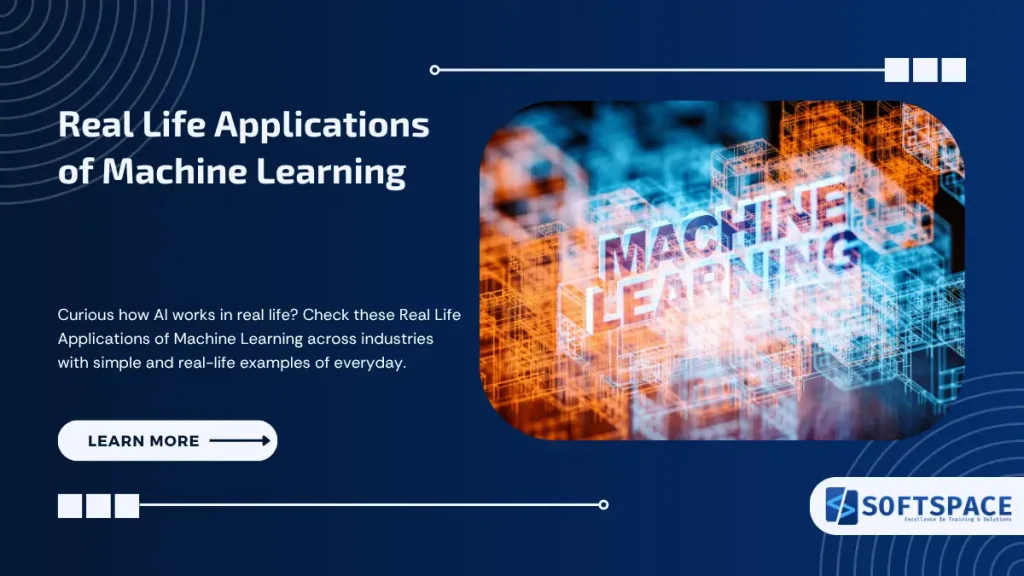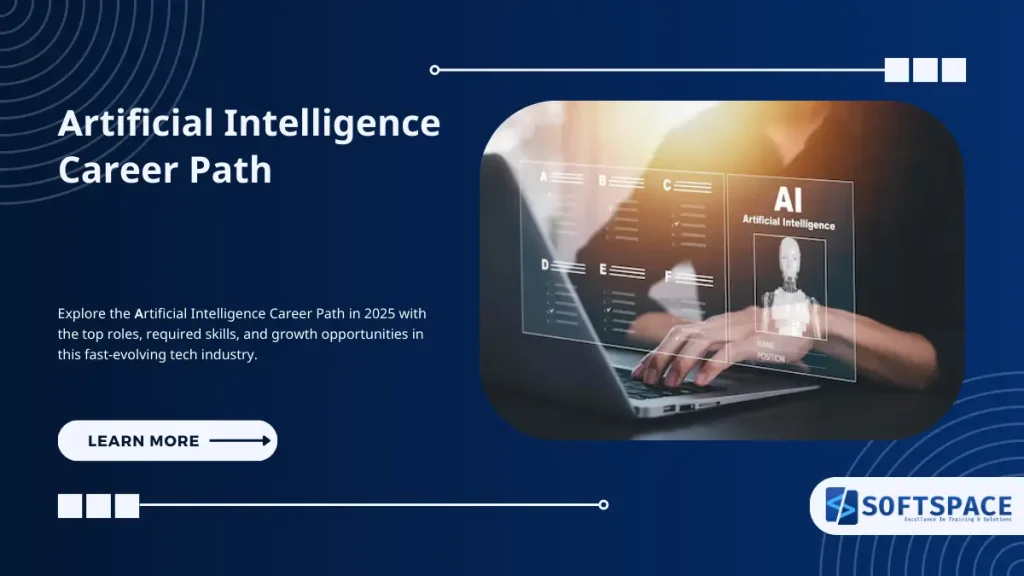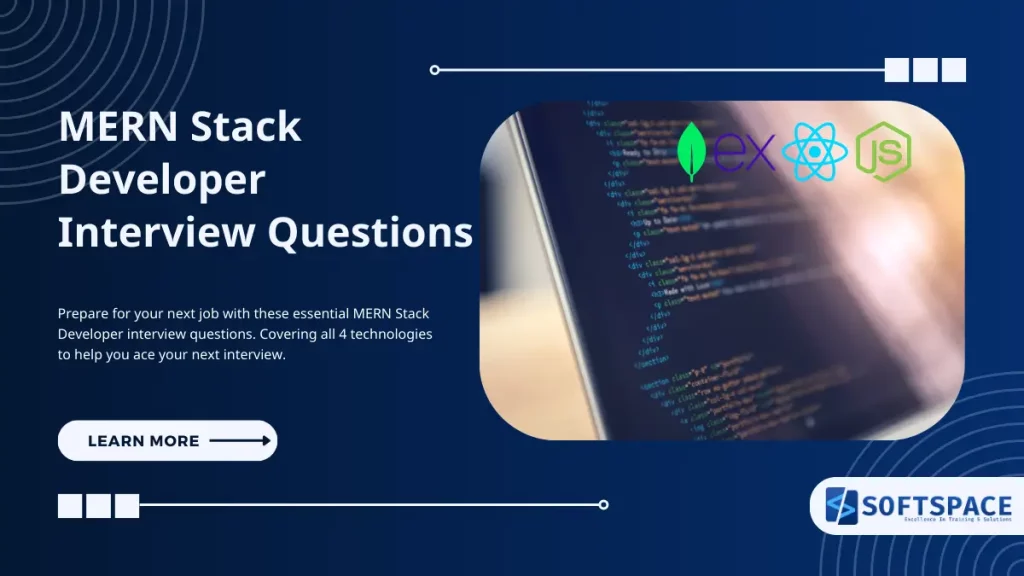Machines are learning and learning superfast.
Machine learning is no longer just a buzzword in tech circles; it’s a transformative force reshaping our everyday lives and industries at an unprecedented pace.
From personalised healthcare and intelligent chatbots to self-driving cars and predictive maintenance, machine learning applications are everywhere, often operating behind the scenes to make our experiences smarter, safer, and more efficient.
As we step into 2025, the real-life applications of machine learning are pushing boundaries, enabling breakthroughs that were unimaginable just a few years ago.
In this blog, we’ll explore the most impactful real life applications of machine learning, with a special focus on the cutting-edge trends and technologies defining the future.

What is Machine Learning?
Machine learning is a branch of artificial intelligence that enables computers to learn from data and improve their performance on tasks without being explicitly programmed. By using algorithms to analyse large datasets, machine learning systems can identify patterns, make predictions, and adapt over time as they are exposed to more information.
This technology underpins many modern applications, from recommendation engines and voice assistants to fraud detection and medical diagnostics, by allowing machines to operate autonomously and become more accurate with experience.
Latest Innovations and Real Life Applications of Machine Learning
The rise of machine learning has revolutionised both daily life and industry by enabling computers to learn from data and make intelligent decisions.
It powers everyday technologies like personalised recommendations, voice assistants, and smart home devices, enhancing user experience through adaptation to individual preferences. In industry, machine learning boosts efficiency by enabling predictive maintenance, improving healthcare diagnostics, detecting financial fraud, and optimising logistics.
Some of the real life applications of machine learning that you are surely familiar with are as follows:
| Application Area | Key Companies/Organisations & Examples | What They’re Doing |
|---|---|---|
| Personalised Customer Experiences | Netflix, Amazon, Spotify, and E-commerce platforms | Using ML to analyse user behaviour and deliver tailored recommendations for shopping, streaming, and content |
| Predictive Maintenance (Manufacturing) | General Electric, Siemens, Bosch | Leveraging sensor data and ML models to predict equipment failures and schedule proactive maintenance |
| Fraud Detection and Cybersecurity | PayPal, major banks, and cybersecurity firms | Monitoring transactions in real time, detecting anomalies, and preventing fraud using ML algorithms |
| Healthcare Diagnostics & Personalised Medicine | Google DeepMind, IBM Watson Health, Sophia Genetics | Analysing medical images, predicting disease progression, and creating custom treatment plans using ML |
| Autonomous Vehicles & Transportation | Tesla, Waymo, Uber, UPS, Amazon | Employing ML for real-time object detection, route optimisation, and safe navigation in self-driving vehicles and logistics |
| Supply Chain Optimisation | Amazon, UPS, DHL | Using ML to forecast demand, manage inventory, and automate logistics for efficient delivery |
| Natural Language Processing & Conversational AI | OpenAI, Google, Microsoft, Meta | Developing intelligent chatbots, virtual assistants, and real-time translation tools with NLP and deep learning |
| Retail Personalisation & Marketing | Retailers (e.g., Walmart, Target), Hilton Hotels | Analysing customer data for targeted marketing, dynamic pricing, and personalised shopping experiences |
| Education (Adaptive Learning) | Khan Academy, Coursera | Using ML to personalise learning content and adapt to individual student needs |
| Media & Entertainment | Netflix, Spotify, TikTok, YouTube | Recommending content, curating playlists, and analysing engagement using ML |
As machine learning continues to evolve, it promises to drive innovation, productivity, and smarter solutions across all sectors. Some of these innovations in various fields are as follows:
Healthcare Revolution: AI-Powered Diagnostics and Personalised Medicine
AI-Powered Diagnostics
Artificial intelligence is transforming healthcare by dramatically improving the accuracy and speed of disease diagnosis. AI algorithms can analyse complex medical data, such as X-rays, MRIs, and even doctors’ notes, to detect abnormalities and patterns that might be missed by the human eye.
These technologies have proven effective in diagnosing a range of conditions, including cancer, cardiovascular diseases, and rare disorders, enabling earlier intervention and more precise treatment planning.
For example, AI-powered platforms like PathAI help pathologists analyse biopsies, reducing diagnostic errors and ensuring patients receive the most appropriate care.
Personalised Medicine
Personalised medicine tailors medical treatments to the unique genetic, lifestyle, and environmental factors of each patient. AI plays a pivotal role here by processing vast amounts of data, such as genomics, electronic health records, and lifestyle information, to identify the most effective therapies for individuals.
This approach moves away from “one-size-fits-all” treatments, allowing clinicians to predict how patients will respond to specific medications and to develop targeted interventions. Companies like Sophia Genetics use AI to interpret genomic data, supporting the creation of precision therapies for conditions like cancer.
Early Disease Detection and Drug Discovery
AI is also revolutionising early disease detection and drug discovery. Wearable health monitors and mobile apps powered by AI can continuously collect and analyse patient data, flagging early signs of disease and enabling proactive care.
In drug discovery, AI models such as DeepMind’s AlphaFold have accelerated the identification of protein structures, expediting the development of new treatments and vaccines. These innovations are making healthcare more predictive, preventive, and patient-centred, ultimately improving outcomes and reducing costs.
Autonomous Vehicles and Smart Transportation
Autonomous vehicles rely on a sophisticated integration of sensors, such as cameras, LiDAR, and radar, combined with advanced machine learning algorithms to perceive and interpret their environment in real time.
Object detection is fundamental, allowing these vehicles to identify and classify nearby cars, pedestrians, cyclists, traffic signs, and obstacles with high accuracy.
Deep learning models, including those based on YOLO and convolutional neural networks, process this sensor data to provide a comprehensive understanding of the surroundings, enabling the vehicle to make critical decisions, such as braking, accelerating, or steering, to ensure safe navigation through complex and dynamic environments.
Recent breakthroughs have achieved detection accuracies exceeding 96% for both 2D and 3D objects, thanks to the integration of deep learning and IoT technologies, further enhancing the safety and reliability of self-driving systems.
This real-time perception is essential for autonomous vehicles to react promptly to hazards, comply with traffic regulations, and optimise their driving strategies.
Route Optimisation and Traffic Management
Beyond object detection, machine learning also plays a pivotal role in optimising routes and managing traffic flow.
By analysing real-time traffic data, historical patterns, and environmental conditions, AI systems can suggest the most efficient routes, reduce congestion, and minimise travel times.
These capabilities are not only crucial for individual autonomous vehicles but also for broader smart transportation networks, where coordinated traffic management leads to safer, greener, and more efficient urban mobility.
Natural Language Processing and Conversational AI
Intelligent Chatbots, Virtual Assistants, and Real-Time Translation
Natural Language Processing (NLP) enables machines to understand, interpret, and respond to human language, making technology interactions feel natural and intuitive.
This is the foundation behind intelligent chatbots and virtual assistants, which can handle customer queries, provide recommendations, and automate routine tasks across sectors such as customer service, healthcare, and e-commerce.
These systems use NLP to process both text and speech, allowing for seamless two-way conversations and even real-time translation between languages, breaking down communication barriers and enhancing global accessibility.
Modern conversational AI leverages machine learning and deep learning to continuously improve its understanding of context, sentiment, and user intent, resulting in more personalised and engaging interactions.
Virtual assistants like Siri and Alexa exemplify how conversational AI can understand commands, manage tasks, and provide information, while real-time translation tools enable multilingual communication with impressive accuracy.
Multimodal Models Handling Text, Audio, and Video Data
Recent innovations have seen the rise of multimodal models that can process and integrate information from multiple sources, text, audio, and video, simultaneously.
These models enhance conversational AI by enabling richer, more context-aware interactions. For instance, a virtual assistant could interpret spoken instructions, analyse accompanying video or images, and respond appropriately, making the conversation more dynamic and human-like.
This evolution in NLP and conversational AI is driving smarter, more adaptive systems capable of understanding complex queries, maintaining context over long conversations, and delivering responses that are both relevant and natural-sounding.
As these technologies advance, they are set to redefine how we interact with digital systems, making communication with machines as effortless as talking to another person.
Cybersecurity and Threat Detection
AI has revolutionised cybersecurity by enabling real-time monitoring, anomaly detection, and proactive defence against cyber threats. Modern AI systems continuously analyse network activity, user behaviour, and system logs to establish a baseline of normal operations.
When unusual patterns such as unexpected data downloads, access to restricted files, or login attempts from unfamiliar locations are detected, the system instantly flags them as suspicious, allowing security teams to act before significant damage occurs.
Unlike traditional security tools that rely on predefined rules, AI-driven platforms use behavioural analysis and machine learning to identify both known and novel attack methods, including zero-day exploits and insider threats.
These systems operate 24/7, ensuring constant vigilance and rapid response, even outside regular business hours. By automating routine tasks like log analysis and alert prioritisation, AI reduces the burden on human analysts and improves the efficiency of security operations.
Integration with existing security infrastructure allows AI-powered solutions to provide a holistic defence, correlating threats across endpoints, networks, cloud environments, and users.
As cyber threats grow more sophisticated, AI’s adaptive learning ensures that detection capabilities evolve alongside emerging attack techniques, helping organisations stay ahead of attackers and maintain a robust security posture.
Supply Chain and Manufacturing Optimisation
Predictive Maintenance
AI-powered predictive maintenance is transforming manufacturing by enabling real-time monitoring of equipment and predicting failures before they occur. By analysing data from sensors and historical records, AI algorithms can detect early warning signs of malfunctions, allowing maintenance teams to intervene proactively.
This approach reduces unplanned downtime, lowers repair and replacement costs, and extends the lifespan of machinery. Maintenance activities are scheduled only when necessary, optimising resource allocation and boosting overall operational efficiency.
Predictive maintenance also supports higher production quality by keeping equipment in optimal condition and reducing variability in machine performance.
Demand Forecasting
Machine learning models are increasingly used to forecast demand by analysing historical sales data, market trends, and external factors such as seasonality or economic shifts.
This enables manufacturers and supply chain managers to optimise inventory levels, plan production more accurately, and respond swiftly to changes in customer demand. Accurate demand forecasting minimises excess inventory, reduces stockouts, and helps streamline the entire supply chain process.
Logistics Automation
AI-driven logistics automation enhances the efficiency of goods movement from suppliers to customers. By processing real-time data on traffic, weather, and inventory, AI systems can optimise delivery routes, schedule shipments, and manage warehouse operations.
Intelligent vision systems help identify available storage space and detect damaged goods, while robotics and simulation tools streamline material handling and production workflows. This results in faster deliveries, reduced operational costs, and improved customer satisfaction.
Smart Homes and IoT
AI and the Internet of Things (IoT) are revolutionising home living by delivering automation, energy efficiency, and advanced security.
Automated Living
AI-powered smart homes learn from residents’ daily routines and preferences, automating tasks such as adjusting lighting, climate control, and appliance scheduling. Voice-activated assistants like Alexa and Google Assistant enable seamless control over devices, from playing music to managing shopping lists and setting reminders.
Over time, these systems personalise settings like starting the coffee machine at your usual wake-up time or adjusting blinds based on sunrise, creating a home environment tailored to your lifestyle.
Energy Management
Smart home AI systems optimise energy usage by monitoring and controlling appliances, lighting, and heating or cooling systems. They analyse usage patterns and adjust settings in real time to reduce unnecessary consumption, leading to lower energy bills and a more sustainable home.
For example, smart thermostats can automatically lower heating when no one is home or run high-energy appliances during off-peak hours, maximising efficiency.
Security Enhancements
AI-driven security systems provide robust protection by integrating smart cameras, sensors, and locks. These systems use facial recognition, behaviour analysis, and real-time monitoring to distinguish between regular activity and potential threats.
Homeowners receive instant alerts for unusual activity, and features like automatic door locking or motion alarms add extra layers of safety. Some setups even allow for remote control and monitoring, ensuring peace of mind whether you’re at home or away.
Reinforcement Learning and Robotics
Reinforcement learning (RL) is reshaping robotics, finance, and healthcare by enabling systems to learn adaptive, human-like decision-making through trial and error.
Rather than relying on explicit programming for every scenario, RL agents interact with their environment, receive feedback in the form of rewards or penalties, and iteratively refine their strategies to maximise long-term success.
Robotics
In robotics, RL empowers machines to master complex behaviours such as navigation, manipulation, and dynamic control. Robots can learn to perform tasks like grasping objects, assembling components, or navigating obstacles by exploring different actions and learning from the outcomes.
For example, industrial robotic arms use RL to optimise assembly line operations, while autonomous vehicles apply RL for trajectory planning, lane following, and collision avoidance. RL also allows robots to adapt to changes, such as hardware wear or new environments, without manual reprogramming.
Finance
In finance, RL is used to develop trading algorithms that adapt to changing market conditions. Agents learn to buy, sell, or hold assets by maximising cumulative returns, factoring in risk and market volatility.
RL-driven strategies can dynamically adjust to new patterns, making them valuable for portfolio management and algorithmic trading.
Healthcare
Healthcare applications of RL include optimising treatment plans, resource allocation, and robotic surgery. RL agents can personalise therapies by learning which interventions yield the best long-term outcomes for individual patients.
In medical robotics, RL enables adaptive control for tasks such as minimally invasive surgery or rehabilitation assistance, improving precision and patient recovery.
Who is leading innovations in real life applications of machine learning?
Several specific organisations are leading innovation in machine learning applications across industries in 2025:
- OpenAI: Renowned for generative AI research and applications, OpenAI’s models like ChatGPT and DALL·E are at the forefront of conversational AI, large language models, and AI-generated content. Their technology powers chatbots, enterprise assistants, and creative tools used globally.
- Google DeepMind: A subsidiary of Alphabet, DeepMind is a pioneer in AI-powered scientific discovery, healthcare, and protein folding (AlphaFold). Their breakthroughs are widely adopted in research, drug discovery, and healthcare diagnostics.
- IBM Watson: IBM Watson offers enterprise-grade AI solutions for industries such as healthcare, finance, and cybersecurity. Their Watson X platform focuses on responsible, explainable AI and large-scale data analytics for regulated sectors.
- NVIDIA: NVIDIA leads in AI hardware and software, providing advanced GPUs and platforms like CUDA that support machine learning in self-driving cars, medical diagnostics, and scientific research.
- Microsoft Azure AI: Microsoft delivers robust AI and machine learning services for business applications, IoT, and big data analytics. Their AI stack, including Copilot, is transforming productivity and enterprise workflows.
- Databricks: Known for its unified analytics platform built on Apache Spark, Databricks helps organisations efficiently manage big data and deploy machine learning models at scale.
- Tesla & Waymo: Both are at the cutting edge of autonomous vehicles, using deep learning for real-time navigation, object detection, and route optimisation.
- IndiaNIC, Neoteric, MobiDev, Dash Technologies: These development companies specialise in building custom machine learning applications for sectors such as e-commerce, healthcare, manufacturing, and IoT, helping businesses implement predictive analytics, recommendation systems, and automation.
- Startups: Companies like Instabase, Grammarly, and People.ai are also making significant strides in applying machine learning to productivity software, language processing, and sales intelligence.
These organisations are not only pushing the boundaries of what machine learning can achieve but are also setting industry standards for ethical, scalable, and impactful AI solutions.
Real Life Applications of Machine Learning: The Future
Generative AI is rapidly advancing, reshaping industries and unlocking new creative and practical possibilities for the years ahead.
- Generative AI tools now produce original text, images, audio, and video content with impressive realism and creativity.
- Platforms like DALL·E, Midjourney, and RunwayML generate high-quality visuals and videos from simple prompts, enabling rapid content creation for marketing, entertainment, and education.
- AI writing assistants draft articles, scripts, and product descriptions, while music and voice generation tools create lifelike audio and custom soundtracks.
This automation streamlines workflows, reduces production costs, and empowers creators to experiment and iterate faster than ever before
Fine-Tuned Vision-Language Models
- The latest generative AI models integrate multiple data types, text, images, audio, and even video, enabling them to understand and generate content across modalities.
- These multimodal models support advanced applications such as interactive storytelling, where narratives include dynamic visuals and soundscapes, and virtual assistants that interpret and respond to users through text, speech, and images.
- Fine-tuning these models for specific industries or tasks enhances their accuracy and relevance, driving hyper-personalisation in marketing, education, and customer service.
Foundation Models for Robotics
- Generative AI is also shaping the future of robotics.
- Foundation models trained on vast datasets can be adapted for a wide range of robotic tasks, from manufacturing and logistics to healthcare and domestic assistance.
- These models enable robots to interpret complex environments, understand instructions in natural language, and learn new skills with minimal additional training.
- As a result, robots are becoming more versatile, adaptive, and capable of collaborating with humans in dynamic settings.

13+ Yrs Experienced Career Counsellor & Skill Development Trainer | Educator | Digital & Content Strategist. Helping freshers and graduates make sound career choices through practical consultation. Guest faculty and Digital Marketing trainer working on building a skill development brand in Softspace Solutions. A passionate writer in core technical topics related to career growth.



